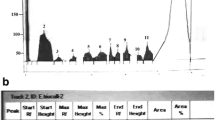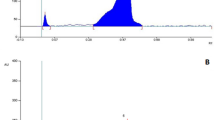Abstract
Arthritis possesses inflammatory components and flavonoids of well-known structures exert anti-inflammatory activity. Here, we aim to evaluate the effects of [4″,5″] dihydro-obovatin and three structurally-defined flavonoids from Tephrosia toxicaria Pers roots on the zymosan-induced temporomandibular joint inflammatory hypernociception in rats as well as their toxicity. Rats were pretreated with the flavonoids (1 and 10 mg/kg) and [4″,5″] dihydro-obovatin (0.1 and 1.0 mg/kg) 1 h before intra-articular zymosan injection (2 mg, 40 μL). Von Frey test was used to evaluate the nociceptive threshold at the 4th hour after zymosan injection. Six hours after zymosan injection, synovial lavage was collected for total cell counting. Acute toxicity assay for [4″,5″] dihydro-obovatin (1, 10, and 100 mg/kg) were performed along with the subchronic toxicity assay by administering [4″,5″] dihydro-obovatin (0.01 mg/kg) or saline solution for 14 consecutive days and the rota-rod test was carried out to determine whether [4″,5″] dihydro-obovatin would impair motor functions. The tested flavonoids and [4″,5″] dihydro-obovatin increased nociceptive threshold and reduced the cell counting in the synovial lavage in the temporomandibular joint compared with the zymosan group. [4″,5”] dihydro-obovatin did not induce toxic effects as well as did not alter the motor function in the rota-rod test. The flavonoids and [4″,5″] dihydro-obovatin exerted antinociceptive and anti-inflammatory effects on the zymosan-induced temporomandibular joint inflammatory hypernociception in rats and the latter did not show significant toxic effects. Therefore, [4″,5″] dihydro-obovatin would be a promising anti-inflammatory and antinociceptive agent.







Similar content being viewed by others
References
Arriaga AMC, Lima JQ, Vasconcelos JN, Oliveira MCF, Andrade-Neto M, Santiago MGP (2009) Unequivocal assignments of flavonoids from Tephrosia sp. (Fabaceae). Magn Reson Chem 47:537–540
Badr-Eldin SM, Ahmed OA (2016) Optimized nano-transfersomal films for enhanced sildenafil citrate transdermal delivery: ex vivo and in vivo evaluation. Drug Des Dev Ther 10:1223–1233
Cairns BE (2010) Pathophysiology of TMD pain—basic mechanisms and their implications for pharmacotherapy. J Oral Rehabil 37:391–410
Cha HJ, Kim YJ, Jeon SY, Kim YH, Shin J, Yun J, Han K, Park HK, Kim HS (2016) Neurotoxicity induced by alkyl nitrites: Impairment in learning/memory and motor coordination. Neurosci Lett 619:79–85
Chaves HV, Ribeiro RA, Souza AM, Silva AAR, Gomes AS, Vale ML (2011) Experimental model of zymosan-induced arthritis in the rat temporomandibular joint: role of nitric oxide and neutrophils. J Biomed Biotechnol 2011:2001–2011
Chen Y, Yan T, Gao C, Cao W, Huang R (2014) Natural products from the genus Tephrosia. Molecules 19:1432–1458
DeCorte BL (2016) Underexplored opportunities for natural products in drug discovery. J Med Chem 59:9295–9304
Denadai-Souza A, Camargo LL, Ribela MT, Keeble JE, Costa SK, Muscará MN (2009) Participation of peripheral tachykinin NK receptors in the carrageenan-induced inflammation of the rat temporomandibular joint. Eur J Pain 13:812–819
Desmarchelier C, Gurm A, Cicia G, Giulietti A (1996) Ritual and medicinal plants of the Ese’ejas of the Amazonian rainforest (Madre de Dios, Peru). J Ethnopharmacol 52:45–51
Dunham NW, Miya TS (1957) A note on a simple apparatus for detecting neurological deficit in rats and mice. J Am Pharm Assoc 46:208–209
Eghbaliferiz S, Iranshahi M (2016) Prooxidant activity of polyphenols, flavonoids, anthocyanins and carotenoids: updated review of mechanisms and catalyzing metals. Phytother Res 9:1379–1391
Ehlers T, Furness S, Robinson TP, Zhong HA, Goldsmith D, Aribser J, Bowen JP (2016) Methionine aminopeptidase type-2 inhibitors targeting angiogenesis. Curr Top Med Chem 13:1478–1488
Foye WO, Lemke TL, Williams DA (2008) Principles of Medicinal Chemistry. Lippincott Williams & Wilkins, Philadelphia
Gidaro MC, Alcaro S, Secci D, Rivanera D, Mollica A, Agamennone M, Giampietro L (2016) Identification of new anti-Candida compounds by ligand-based pharmacophore virtual screening. J Enzym Inhib Med Chem 31:1703–1706
Gothai S, Ganesan P, Park SY, Fakurazi S, Choi D, Arulselvan P (2016) Natural phyto-bioactive compounds for the treatment of type 2 diabetes: inflammation as a target. Nutrients. https://doi.org/10.3390/nu8080461
Graff-Radford SB, Abbott JJ (2016) Temporomandibular disorders and headache. Oral Maxillofac Surg Clin N Am 28:335–349
Haque S, Nawrot DA, Alakurtti S, Ghemtio L, Yli-Kauhaluoma J, Tammela P (2014) Screening and characterization of antimicrobial properties of semisynthetic betulin derivatives. PLoS One 9(7):e102696. https://doi.org/10.1371/journal.pone.0102696
Hassan LE, Dahham SS, Fadul SM, Umar MI, Majid AS, Khaw KY (2016) Evaluation of in vitro and in vivo anti-inflammatory effects of (-)-pseudosemiglabrin, a major phytoconstituent isolated from Tephrosia apollinea (Delile) DC. J Ethnopharmacol 193:312–320
Jacobs H, Peters R, den Hartog GJ, van der Vijgh WJ, Bast A, Haenen GR (2011) Identification of the metabolites of the antioxidant flavonoid 7-mono-O-(β-hydroxyethyl)-rutoside in mice. Drug Metab Dispos 39:750–756
Lima ABL, Paixão MS, Melo M, Santana MT, Damascena MP, Dias AS (2013) Orofacial antinociceptive effect and antioxidant properties of the hydroethanolic extract of Hyptis fruticosa salmz ex Benth. J Ethnopharmacol 146:192–197
Meotti FC, Ardenghi JV, Pretto JB, Souza MM, d’ Avila, Moura J, Junior AC (2006) Antinociceptive properties of coumarin, steroid and dihydrostyryl-2-pyrones from Polygala sabulosa (Polygalaceae) in mice. J Pharm Pharmacol 58:107–112
Millan MJ (1999) The induction of pain: an integrative review. Prog Neurobiol 57:1–164
Miller LC, Tainter ML (1944) Estimation of the ED50 and its error by means of logarithmic-probity graph paper. Proc Soc Exp Biol Med 57:261–264
Mossa AT, Heikal TM, Belaiba M, Raoelison EG, Ferhout H, Bouajila J (2015) Antioxidant activity and hepatoprotective potential of Cedrelopsis grevei on cypermethrin induced oxidative stress and liver damage in male mice. BMC Complement Altern Med 15:251. https://doi.org/10.1186/s12906-015-0740-2
Plioukas M, Gabrieli C, Lazari D, Kokkalou E (2015) Phytochemical analysis with the antioxidant and aldose reductase inhibitory capacities of Tephrosia humilis aerial parts’ extracts. Nat Prod Res 24:1–7
Silva AAR, Bezerra MM, Chaves HV, Pereira KMA, Aguiar JA, Pinto VPT (2013) Protective effect of Chresta martii extract against indomethacin-induced gastric lesions in mice. J Nat Med 67:143–151
Val DR, Bezerra MM, Silva AAR, Pereira KMA, Rios LC, Lemos JC (2014) Tephrosia toxicaria Pers. reduces temporomandibular joint inflammatory hypernociception: the involvement of the HO-1 pathway. Eur J Pain 18:1280–1289
Xiao X, Wang X, Gui X, Chen L, Huang B (2016) Natural flavonoids as promising analgesic candidates: a systematic review. Chem Biodivers 13:1427–1440
Xu F, Ding Y, Guo Y, Liu B, Kou Z, Xiao W (2016) Anti-osteoporosis effect of Epimedium via an estrogen-like mechanism based on a system-level approach. J Ethnopharmacol 177:148–160
Acknowledgements
This work was supported by Brazilian grants from Fundação de Amparo à Ciência e Tecnologia do Estado de Pernambuco, Fundação Cearense de Apoio ao Desenvolvimento Científico e Tecnológico (FUNCAP), Conselho Nacional de Desenvolvimento Científico e Tecnológico (CNPq), Coordenação de Aperfeiçoamento de Pessoal de Nível Superior (CAPES), and Instituto de Biomedicina do Semi-Árido Brasileiro (INCT-IBISAB).
Author information
Authors and Affiliations
Corresponding author
Ethics declarations
Conflict of interest
The authors declare that they have no competing interests.
Electronic supplementary material
Rights and permissions
About this article
Cite this article
do Val, D.R., Chaves, H.V., Gomes, F.I.F. et al. The semi-synthetic molecule [4″,5″] dihydro-obovatin isolated from Tephrosia Toxicaria pers reduces zymosan-induced temporomandibular joint inflammatory hypernociception in rats. Med Chem Res 27, 1004–1012 (2018). https://doi.org/10.1007/s00044-017-2123-3
Received:
Accepted:
Published:
Issue Date:
DOI: https://doi.org/10.1007/s00044-017-2123-3




